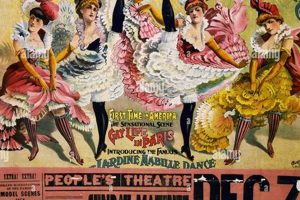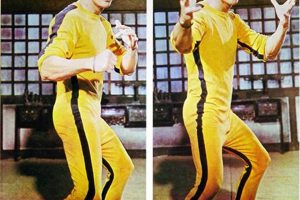These graphic artworks served primarily as advertisements for motor racing events of the past. Often featuring stylized depictions of racing vehicles, drivers, and event details, they were intended to attract spectators to venues and promote the sport. As examples, posters from the early Grand Prix races or the 24 Hours of Le Mans are sought-after examples of this art form.
The significance of these historical artifacts lies in their reflection of cultural and technological developments in both motorsports and graphic design. They offer insights into the evolution of automotive technology, the changing aesthetics of advertising, and the social contexts surrounding racing events. The value of this historical artifact is driven by their rarity, artistic merit, and historical significance as pieces of motorsports heritage.
The appeal and historical value of such items make them desirable for collectors, historians, and automotive enthusiasts. Subsequent sections will explore their impact on graphic design and detail the key elements affecting their value in the collectors’ market.
Tips for Collectors of Historic Motorsport Advertising Art
This section offers guidance for individuals interested in acquiring and preserving vintage motorsport advertising art. Careful consideration of the following aspects is essential for building a meaningful and valuable collection.
Tip 1: Research and Authentication: Conduct thorough research into the historical context of each piece. Verify authenticity by examining printing techniques, paper quality, and any available provenance records. Consult with experts in the field to assess authenticity.
Tip 2: Condition Assessment: Evaluate the items condition meticulously. Look for signs of damage, such as tears, fading, water stains, or restoration attempts. A poster in excellent condition will generally command a higher value.
Tip 3: Rarity and Desirability: Assess the rarity of the piece. Limited-edition prints or posters from significant races tend to be more valuable. Also, consider the desirability of the subject matter, such as iconic drivers or historically important races.
Tip 4: Preservation and Storage: Implement proper storage techniques to prevent deterioration. Store posters flat, using acid-free materials for protection. Avoid direct sunlight and excessive humidity.
Tip 5: Framing and Display: Opt for professional framing using archival materials. UV-protective glass helps prevent fading. Consider the aesthetic presentation of the piece within its display environment.
Tip 6: Documentation and Insurance: Maintain detailed records of each purchase, including provenance, purchase price, and condition reports. Obtain appropriate insurance coverage to protect against loss or damage.
Tip 7: Market Awareness: Stay informed about current market trends and auction results. Attend auctions and exhibitions to develop a better understanding of pricing and value fluctuations.
Adherence to these guidelines will facilitate the responsible acquisition, preservation, and appreciation of historic motorsport advertising art. Careful research, meticulous condition assessment, and appropriate storage practices are essential for ensuring the longevity and value of such items.
The subsequent sections will delve into the specific factors influencing the value of a vintage racing advertisement and provide examples of notable pieces in the market.
1. Artistic Style
The artistic style evident in motor racing advertisements serves as a visual timestamp, reflecting the prevailing aesthetic sensibilities of its era. The creative choices of illustrators and designers directly influence the perceived value and desirability of these historical items.
- Art Deco Influence
The Art Deco movement, prominent in the 1920s and 1930s, significantly impacted poster design. This style is characterized by geometric shapes, streamlined forms, and bold, vibrant colors. Posters from this period often depict racing vehicles and figures with a sense of speed and dynamism, utilizing techniques like airbrushing to create smooth, polished surfaces. The Monaco Grand Prix posters from this era exemplify this trend.
- Mid-Century Modernism
Following World War II, Mid-Century Modernism emerged, emphasizing clean lines, simplified forms, and functional design. Motor racing advertisements from the 1950s and 1960s reflect this shift, with a focus on clarity and visual impact. Designers employed bold typography and limited color palettes to convey information effectively. Swiss Style design principles, known for their grid-based layouts and sans-serif fonts, became influential in this period.
- Pop Art and Psychedelia
The 1960s also saw the rise of Pop Art and Psychedelic styles. These movements embraced bold, often exaggerated imagery, and unconventional color combinations. While less common in mainstream motor racing advertising, some posters incorporated these elements, particularly for smaller, more experimental events. These styles challenged traditional notions of artistic representation.
- Realism and Photo-Illustration
Throughout the history of motor racing advertising, realism has remained a consistent approach. Detailed illustrations or photographs depicting racing vehicles and drivers in action aim to capture the excitement and intensity of the sport. These posters often prioritize accuracy and detail, appealing to enthusiasts seeking an authentic representation of racing events. Technological advancements in printing allowed for increasingly realistic depictions over time.
The diverse artistic styles found in motor racing advertisements offer insights into the cultural and aesthetic trends of each era. These creative choices not only served to promote racing events but also contributed to the historical and artistic value of these collectible items. An understanding of these styles is essential for collectors seeking to appreciate the nuances of this unique art form.
2. Historical Context
The historical context surrounding a motor racing advertisement significantly influences its value and appeal. These posters are not merely decorative items but rather historical documents that provide insight into the socio-economic, technological, and cultural landscape of their time. Events such as the pre-war Grand Prix era, the post-war reconstruction period, or the rise of specific racing series each left distinct marks on poster design and content. For example, a poster advertising a race held shortly after World War II may reflect a sense of optimism and technological advancement, while one from the interwar period might showcase Art Deco aesthetics and a focus on national pride. The specific political climate, economic conditions, and technological innovations of the era directly shaped the message and visual elements of these advertisements.
The significance of historical context also extends to understanding the particular race or event being advertised. A poster for a race that witnessed a pivotal moment in motorsports history, such as a record-breaking performance or a tragic accident, inherently possesses greater historical weight. Knowing the drivers, teams, and technological innovations involved in a specific race adds layers of meaning to the poster. For instance, a poster from the 1955 Le Mans race, marred by a catastrophic accident, is both historically significant and emotionally charged. The event’s impact on safety regulations and the sport’s evolution makes the poster a valuable artifact beyond its artistic merit. Collectors often seek posters linked to iconic races or events, driving up their value and demand.
In conclusion, appreciating the historical context is paramount for collectors and enthusiasts. It allows for a deeper understanding of the artistic choices, cultural influences, and historical significance embedded within these vintage items. Recognizing the historical forces that shaped each poster transforms it from a mere piece of paper into a window into the past, providing valuable insights into the evolution of motorsports and its cultural impact.
3. Rarity & Condition
The intersection of scarcity and preservation dictates a significant portion of the collectible value associated with historic motorsport advertisements. Limited print runs, intentional destruction after an event, and the passage of time contribute to the scarcity of surviving examples. This inherent rarity establishes a baseline value, which is then significantly modified by the item’s state of preservation. A poster produced in limited quantities from a historically significant race, if found in pristine condition, commands a premium substantially exceeding that of a more common poster or one exhibiting significant damage.
Condition assessment involves careful scrutiny for defects such as tears, fading, staining, and restoration efforts. Originality is also paramount; reprints or reproductions hold comparatively little value in the collectors’ market. Professional restoration, while potentially improving the aesthetic appearance, can also diminish value if not executed using archival-quality materials and techniques. For example, a poster from the 1930s Monaco Grand Prix, of which only a few original copies are known to exist, would be worth significantly less if it exhibits water damage or significant creasing than a similar poster in near-mint condition. The relative availability of posters from specific eras also influences value; pre-war posters are generally rarer due to wartime paper drives and less emphasis on preservation at the time.
Ultimately, a collector’s assessment must balance the desirability of a particular poster against its physical condition. While extreme rarity can sometimes offset minor imperfections, significant damage invariably diminishes value. The highest prices are consistently achieved by examples that combine inherent scarcity with exceptional preservation, making a meticulous evaluation of both factors essential for informed acquisition and long-term appreciation.
4. Printing Technique
The method of reproduction directly impacts the value, authenticity, and aesthetic qualities. Understanding the various printing techniques employed throughout the history of this art form is essential for collectors and historians.
- Lithography
Lithography, a planographic process, became a dominant technique for mass-producing color posters from the late 19th century onwards. It involves drawing an image on a stone or metal plate with a greasy crayon or ink, treating the plate to make the image receptive to ink and the non-image areas receptive to water, and then transferring the image to paper. This technique allowed for vibrant colors and detailed illustrations, contributing to the visual appeal of many vintage racing posters. Examples include early posters from the Targa Florio and Mille Miglia, which often exhibit the characteristic smoothness and rich colors associated with lithographic printing.
- Screen Printing (Serigraphy)
Screen printing, also known as serigraphy, utilizes a stencil applied to a mesh screen to transfer ink onto paper. This technique gained prominence in the mid-20th century due to its ability to produce bold colors and graphic designs, particularly in the Pop Art era. Some mid-century racing posters, especially those promoting smaller or more avant-garde events, employed screen printing for its distinctive aesthetic. The thick ink layers and sharp edges characteristic of screen printing can often be observed under magnification.
- Letterpress Printing
Letterpress printing, an older technique, involves inking raised letters or images and pressing them directly onto paper. While less common for large-scale color posters, letterpress was often used for smaller promotional materials or text-based elements on larger posters. The distinctive impression left by the raised type can be felt and seen, creating a tactile quality. Early racing posters might incorporate letterpress for event details or sponsor information.
- Offset Lithography
Offset lithography, a refinement of the original lithographic process, involves transferring the inked image from a plate to a rubber blanket and then to the paper. This indirect method allows for finer detail and higher print quality, becoming the dominant technique for mass-produced posters in the latter half of the 20th century. Many post-war racing posters, particularly those from the 1960s onwards, were printed using offset lithography, allowing for photo-realistic images and consistent color reproduction. The dot pattern characteristic of offset printing can be observed under magnification.
The choice of printing technique significantly impacted the visual style and durability of vintage motor racing advertisements. Recognizing these techniques aids in authentication, dating, and assessing the overall quality of these historical artifacts. The interplay between artistic design and printing technology shaped the aesthetic landscape of this unique art form.
5. Event Significance
The magnitude of the race or event depicted directly influences the desirability and valuation of historic motorsports advertisements. The historical weight, cultural impact, and lasting legacy of a particular competition contribute significantly to a poster’s overall appeal.
- Inaugural Races and Milestone Events
Posters from the first-ever running of a race, such as the inaugural Monaco Grand Prix or the first 24 Hours of Le Mans, possess inherent historical significance. Similarly, races that marked a technological breakthrough, a record-breaking performance, or a significant rule change are highly sought after by collectors. These events often represent pivotal moments in the evolution of motorsports.
- Races Featuring Legendary Drivers
Advertisements showcasing iconic drivers, particularly those associated with major victories or defining moments in their careers, command a premium. Posters depicting races where drivers like Juan Manuel Fangio, Stirling Moss, or Ayrton Senna achieved notable feats are highly valued. The driver’s persona and impact on the sport amplify the poster’s historical and emotional connection for collectors.
- Races Marked by Tragedy or Controversy
While morbid in some respects, posters associated with races marred by significant accidents or controversies hold a unique historical significance. The 1955 Le Mans disaster, for example, left an indelible mark on motorsports history, and related advertising materials are highly sought after, albeit with a somber understanding of their historical context. These posters serve as a reminder of the inherent risks of racing and the subsequent impact on safety regulations.
- Races Representing National or Cultural Pride
Events that became symbols of national or cultural identity, such as the Italian Mille Miglia or the German Grand Prix, often carry a strong emotional resonance for collectors. Posters promoting these races reflect national pride and the cultural significance of motorsports within a specific country. The patriotic imagery and design elements contribute to their enduring appeal.
In essence, the more impactful and memorable the race or event, the greater the value and desirability of its corresponding advertising materials. Collectors seek posters that encapsulate pivotal moments in motorsports history, reflecting the sport’s evolution, technological advancements, and enduring cultural impact.
Frequently Asked Questions
The following questions address common inquiries regarding the identification, valuation, and preservation of these vintage artifacts.
Question 1: How can the authenticity of a supposed historical motorsports advertisement be verified?
Authenticity verification requires careful examination of several factors, including printing techniques consistent with the purported era, paper stock analysis, and comparison with known authentic examples. Consulting with experts and reviewing provenance documentation are also advisable.
Question 2: What are the key indicators of a historic motorsport advertisement’s condition, and how do they influence value?
Condition assessment involves evaluating the presence of tears, fading, staining, or restoration. The extent of these imperfections directly affects the item’s value, with pieces in excellent original condition commanding significantly higher prices.
Question 3: Which races or events tend to be associated with the most valuable historic motorsport advertisements?
Posters from inaugural races, races featuring legendary drivers, or races marked by significant historical events or controversies typically hold higher value. The event’s historical weight and cultural impact are key determinants.
Question 4: What are the recommended storage and preservation techniques for ensuring the longevity of a historic motorsport advertisement?
Proper storage involves using acid-free materials, storing posters flat, and avoiding direct sunlight and excessive humidity. Professional framing with UV-protective glass is also recommended.
Question 5: How do printing techniques influence the value and appeal of a historic motorsport advertisement?
Different printing methods, such as lithography, screen printing, and offset lithography, were used in different eras and each technique carries its own aesthetic qualities. The printing process can impact the visual style, durability, and overall appeal of the item. Identifying the technique also helps verify the item’s age and authenticity.
Question 6: What role does provenance play in determining the value of a historic motorsport advertisement?
Provenance, the documented history of ownership, can significantly enhance value, especially if the poster can be traced back to the race organizers, a driver or team, or a notable collector. A clear provenance provides reassurance about the item’s authenticity and historical importance.
Understanding these factors is crucial for both novice and experienced collectors. Careful research, meticulous condition assessment, and proper preservation are essential for maximizing the value and enjoyment derived from these unique historical artifacts.
The subsequent section will provide a curated selection of resources for further exploration of the topic.
Conclusion
This exploration of vintage auto racing posters has illuminated their multifaceted value, extending beyond mere promotional material. These artifacts offer a unique lens through which to examine the evolution of motorsports, the development of graphic design, and the shifting cultural landscapes of the 20th century. From artistic styles and printing techniques to event significance and historical context, each element contributes to their appeal and collectibility.
Continued research and preservation efforts are vital to ensure these valuable pieces of automotive and artistic history are available for future generations. The preservation of this cultural heritage rests on careful study, ethical collecting practices, and a dedication to understanding the rich stories encoded within each poster. The diligent pursuit of knowledge and responsible stewardship will ensure the legacy endures.







